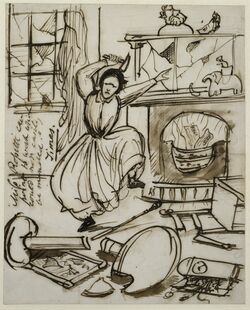Philosophy:Tantrum
A tantrum, temper tantrum, lash out, meltdown, fit or hissy fit is an emotional outburst,[1][2][3] usually associated with those in emotional distress, that is typically characterized by stubbornness, crying, screaming, violence,[4] defiance,[5] angry ranting, a resistance to attempts at pacification, and, in some cases, hitting and other physically violent behavior. Physical control may be lost; the person may be unable to remain still; and even if the "goal" of the person is met, they may not be calmed. Throwing a temper tantrum can lead to a child getting detention or being suspended from school for older school age children, and can result in a timeout or grounding, complete with room or corner time, at home.[6][7][8][9][10][11] A tantrum may be expressed in a tirade: a protracted, angry speech.[6][7][12]
In early childhood
Tantrums are one of the most common forms of problematic behavior in young children but tend to decrease in frequency and intensity as the child gets older.[13] For a toddler, tantrums can be considered as normal, and even as gauges of developing strength of character.[14][15][16]
While tantrums are sometimes seen as a predictor of future anti-social behaviour,[17] in another sense they are simply an age-appropriate sign of excessive frustration,[18] and will diminish over time given a calm and consistent handling.[19][20][21] Parental containment where a child cannot contain themself—rather than what the child is ostensibly demanding—may be what is really required.[22]
Selma Fraiberg warned against "too much pressure or forceful methods of control from the outside" in child-rearing: "if we turn every instance of pants changing, treasure hunting, napping, puddle wading and garbage distribution into a governmental crisis we can easily bring on fierce defiance, tantrums, and all the fireworks of revolt in the nursery".[23]
Intellectual and developmental disorders
Some people who have developmental disorders such as Autism, ADHD, and intellectual disability[24] or even a developmental disability, could be more vulnerable to tantrums than others, although anyone experiencing brain damage (temporary or permanent) can suffer from tantrums.[25] Anyone may be prone to tantrums once in a while, regardless of gender or age.[26][27] However, a meltdown due to sensory overload (which even neurotypical children can experience) is not the same as a temper tantrum.[28]
Aberrations
File:Tantrums vs. meltdowns.webm Freud considered that the Wolf Man's development of temper tantrums was connected with his seduction by his sister: he became "discontented, irritable and violent, took offence on every possible occasion, and then flew into a rage and screamed like a savage".[29] Freud linked the tantrums to an unconscious need for punishment driven by feelings of guilt[30]—something which he thought could be generalised to many other cases of childhood tantrums.[31][32]
Heinz Kohut contended that tantrums were rages of anger,[33] caused by the thwarting of the infant's grandiose-exhibitionist core. The blow to the inflated self-image, when a child's wishes are (however justifiably) refused, creates fury because it strikes at the feeling of omnipotence.[34]
Jealousy over the birth of a sibling, and resulting aggression, may also provoke negativistic tantrums, as the effort at controlling the feelings overloads the child's system of self-regulation.[35][36]
In later life
Writer William Makepeace Thackeray claimed that in later life "you may tell a tantrum as far as you can see one, by the distressed and dissatisfied expression of its countenance—'Tantrumical', if we may term it so".[37]
Heinz Kohut contended that "the baby’s core is likely to contain a self-centred, grandiose-exhibitionist part", and that "tantrums at being frustrated thus represent narcissistic rages"[33] at the blow to the inflated self-image. With "a child confronted with some refusal ... regardless of its justifications, the refusal automatically provokes fury, since it offends his sense of omnipotence".[34]
The willingness of the celebrity to throw tantrums whenever thwarted to the least degree[38] is a kind of acquired situational narcissism[39] or tantrumical behavior.
If tantrums are shown by older people, they might often be signs of immaturity or a mental or developmental disability; and often autistic or ADHD meltdowns are incorrectly labelled tantrums. It can also occur in neurotypical people under extreme stress.[40]
See also
- Acting out
- Running amok
- Philippic (tirade, orations)
References
- ↑ Album, Cabinet (1830). "The Cabinet Album A Collection of Original and Selected Literature". The (Hurst, Chance and Company): 92.
- ↑ Foote, Samuel (1765). "The Dramatic Works Volume 1". The Dramatic Works (P. Vaillant) 1: 40–41.
- ↑ Payn, James (1869). Married Beneath Him. A novel. By the author of "Lost Sir Massingberd" James Payn. The British Library. pp. 369.
- ↑ O'Hara, Kane (1770). "Midas An English Burletta. As it is Performed at the Theatre-Royal, in Covent-Garden". Midas an English Burletta. As It is Performed at the Theatre-Royal, in Covent-Garden: 20.
- ↑ GOMBERT, A. J. (1825). "The French Drama ... with Notes Critical and Explanatory, by A. G. Volume 2 of The French Drama ... with Notes Critical and Explanatory, by A. G". The French Drama... (The British Library) 2: 47.
- ↑ Jump up to: 6.0 6.1 Penelope Leach. "What is a tantrum?". http://www.babycentre.co.uk/toddler/penelopeleach/whatisatantrum/.
- ↑ Jump up to: 7.0 7.1 "Temper Tantrums". http://kidshealth.org/parent/emotions/behavior/tantrums.html.
- ↑ Karisa Ding (July 26, 2017). "Tantrums". http://www.babycenter.com/0_tantrums_11569.bc.
- ↑ Jan Hunt. "When a Child Has a Tantrum". The Natural Child Project. http://www.naturalchild.org/jan_hunt/tantrum.html.
- ↑ Mullen, J.K. (1983). "Understanding and managing the temper tantrum". Child Care Quarterly 12 (1): 59–70. doi:10.1007/BF01258080.
- ↑ Geelerd, E.R. (1945). "Observations on temper tantrums in children". American Journal of Orthopsychiatry 15 (2): 238–246. doi:10.1111/j.1939-0025.1945.tb04937.x.
- ↑ Daniels, Elizabeth; Mandleco, Barbara; Luthy, Karlen E. (2012). "Assessment, management, and prevention of childhood temper tantrums". Journal of the American Academy of Nurse Practitioners 24 (10): 569–573. doi:10.1111/j.1745-7599.2012.00755.x. PMID 23006014.
- ↑ Banham Bridges, Katharine M. (1932). "Emotional Development in Early Infancy". Child Development 3 (4): 324–341. doi:10.1111/j.1467-8624.1932.tb05842.x.
- ↑ Robin Skynner; John Cleese (1993). Families and how to survive them. p. 177.
- ↑ Isaacs, S. (1940). "Temper tantrums in early childhood in their relation to internal objects.". The International Journal of Psychoanalysis 21: 280–293.
- ↑ Solter, A. (1992). "Understanding Tears and Tantrums". Young Children 47 (4): 64–68.
- ↑ Potegal, Michael; Davidson, Richard J. (June 2003). "Temper Tantrums in Young Children". Journal of Developmental & Behavioral Pediatrics 24 (3): 140–147. doi:10.1097/00004703-200306000-00002. PMID 12806225.
- ↑ Green, J.A.; Whitney, P.G.; Potegal, M. (2011). "Screaming, yelling, whining, and crying: Categorical and intensity differences in vocal expressions of anger and sadness in children's tantrums.". Emotion 11 (5): 1124–1133. doi:10.1037/a0024173. PMID 21707157.
- ↑ Roy Benaroch (2008). Solving Health and Behavioural Problems from Birth Through Preschool. p. 157.
- ↑ Kopp, C.B. (1989). "Regulation of distress and negative emotions: A developmental view.". Developmental Psychology 25 (3): 343–354. doi:10.1037/0012-1649.25.3.343.
- ↑ Levine, Linda (1995). "Young Children's Understanding of the Causes of Anger and Sadness". Child Development 66 (3): 967–709. doi:10.2307/1131944. PMID 7789196.
- ↑ Patrick Casement (1990). Further Learning from the Patient. pp. 113–4.
- ↑ Selma H. Fraiberg (1987). The Magic Years. p. 65.
- ↑ Luiselli, J.; Murbach, L. (2002). "Providing Instruction from Novel Staff as an Antecedent Intervention for Child Tantrum Behavior in a Public School Classroom". Education and Treatment of Children 25 (3): 356–365.
- ↑ Lancioni, G. E.; Smeets, P. M.; Ceccarani, P. S.; Capodaglio, L.; Campanari, G. (1984). "Effects of gross motor activities on the severe self-injurious tantrums of multihandicapped individuals.". Applied Research in Mental Retardation 5 (4): 471–482. doi:10.1016/S0270-3092(84)80039-9. PMID 6240965.
- ↑ Sandra Ketcham. "Temper Tantrums and Autism". LoveToKnow. http://autism.lovetoknow.com/Temper_Tantrums_and_Autism.
- ↑ Osterman, Karin; Bjorkqvist, Kaj (April 1, 2010). "A Cross-Sectional Study of Onset, Cessation, Frequency, and Duration of Children's Temper Tantrums in a Nonclinical Sample". Psychological Reports 106 (2): 448–454. doi:10.2466/pr0.106.2.448-454. PMID 20524545.
- ↑ Bennie, Maureen (2 February 2016). "Tantrum vs Autistic Meltdown: What Is The Difference?". Autism Awareness Centre Inc.. https://autismawarenesscentre.com/what-is-the-difference-between-a-tantrum-and-an-autistic-meltdown/.
- ↑ Sigmund Freud. Case Histories II (PFL 9). p. 242.
- ↑ Sigmund Freud. Case Histories II (PFL 9). p. 257.
- ↑ Sigmund Freud. Case Histories II (PFL 9). pp. 242 & 257–8.
- ↑ M., R.J, Potegal, Davidson (1997). "Young children's post tantrum affiliation with their parents". Aggressive Behavior 23 (5): 329–341. doi:10.1002/(SICI)1098-2337(1997)23:5<329::AID-AB3>3.0.CO;2-D.
- ↑ Jump up to: 33.0 33.1 H. Goldenberg; I. Goldenberg (2007). Family Therapy. p. 172.
- ↑ Jump up to: 34.0 34.1 Edmund Bergler in J. Halliday/P. Fuller eds., The Psychology of Gambling (London 1974) p. 182
- ↑ Selma H. Fraiberg (1987). The Magic Years. p. 152.
- ↑ Dennis, Tracy A. (2006). "Emotional self-regulation in preschoolers: The interplay approach reactivity, and control capacities". Developmental Psychology 42 (1): 84–97. doi:10.1037/0012-1649.42.1.84. PMID 16420120.
- ↑ William Makepeace Thackeray (1848). The Irish Sketch Book. J. Winchester. p. 138. https://archive.org/details/irishsketchbook01thacgoog.
- ↑ Cooper Lawrence, The Cult of Celebrity (2009) p. 72
- ↑ Simon Crompton, All about Me (London 2007) p. 176
- ↑ "North Jersey". http://www.northjersey.com/news/health-news/adult-temper-tantrums-1.1126134.
External links
 |



